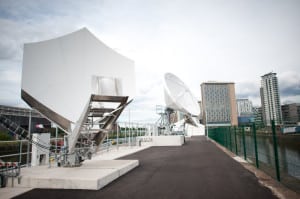Latest News
[Via Satellite 02-24-2016] SIS Live is in the midst of evolving from a company based largely on satellite connectivity to one that provides multiple forms of communications. The transition, according to Managing Director David Meynell, picked up considerable momentum last year, as the company sought to diversify from its traditional Satellite Newsgathering (SNG) revenues.
Meynell told Via Satellite that the development of hybrid, or “bonded” networks in the United Kingdom and elsewhere convinced SIS Live of the need to adapt as well. Though SIS Live has one of, if not the largest fleets of independent satellite trucks in the world, the proliferation of fiber networks has encroached on previously safe satellite territory.
“In the last couple of years we positioned ourselves by becoming more of a connectivity company rather than a satellite company,” Meynell said. “Last year was the first full year where we were really pushing and driving those services, and it was very successful. We have put a lot of fiber infrastructure into the U.K. marketplace, and we are using our satellite trucks more to help us get content from venues for live events like sports and concerts, etc.”
Fiber and remote production capabilities are the two areas SIS Live is investing in the most today, Meynell said. These technologies are part of the company’s strategy to hold its ground as a top connectivity provider for critical media content.
“If we had continued to just offer our traditional types of services, then the company no doubt would have started reducing in size. We are very ambitious — as most companies are — to continue to grow,” Meynell explained, adding that while SIS Live signed a major seven-year Ka-band SNG contract for ITV and ITN News in the U.K., a couple of years ago, other contracts were signaling a shift in the way news broadcasters were delivering content. “There is lots of soft news, and bonded networks have been very successful. As technology gets better, bonded networks become more efficient for other tasks. We could see that happening two to three years ago, and it was really changing the marketplace.”
Meynell said this change does not mean satellite does not have a place. Rather, the company recently scaled up capacity from both Eutelsat and SES. Meynell sees satellite fitting into a larger connectivity picture, providing redundancy and assurance of coverage for critical events.
“Our satellite fleet is still essential to our growth because it supports a lot of the fiber infrastructure we have as well. Last year we had the Rugby World Cup and we covered that for a global audience. I think it was the third most watched sporting event in the world behind the soccer World Cup and the Olympics. We provided all of the connectivity for that, which was a combination of fiber, satellite and microwave. We had very high levels of [Service Level Agreements] SLA with our customer, and therefore we provided triple resilience. The satellite link was absolutely key to us securing that contract,” he said.
Satellite is a big component of SIS Live’s international strategy too. Meynell highlighted the Middle East as a strong market for the company. SIS Live increased its satellite capacity as well as its Occasional Use (OU) sales team in this market to cover news and sporting events. Meynell said the company has been increasing its presence in the region for the past three to four years, and envisions enhanced hybrid services that leverage 3G and 4G cellular connectivity along with satellite.
Beyond Europe and the Middle East, he said the bulk of SIS Live’s international growth comes from the sale of small, lightweight Very Small Aperture Terminals (VSAT). Ultra-HD is another area Meynell described as a growth market with potential for satellite. He said for a while 4K Ultra-HD was suspect because of the false starts that came with 3-D, but now is growing very quickly.
“I think all content will shift that way, but it will be driven by live events. I think for most sports, people want to shoot in Ultra-HD, so that will drive it, but as soon as we get the majority of sports delivered in Ultra-HD, which will take a couple of years there’s no doubt … the trickle effect will become a stream and then a torrent. It will start with those big events until it becomes prevalent on Direct-to-Home (DTH) platforms,” he said.
Meynell estimates it will take roughly three to five years for most content to switch to 4K, but describes the transition as inevitable. However, he expects satellite DTH will face competition from new terrestrial ultra high speed fiber. SIS Live can already transmit 4K today, he said, using existing infrastructure. Alongside 4K, he said remote production will become more prevalent as well. Meynell said SIS Live conducted trials over the last 18 months providing soccer and horse racing using remote production successfully.
“Being a connectivity provider, we love the idea of remote production because I would rather send 20 feeds back to a central location to produce than one or two. So remote production is great for a connectivity provider, and we see that as an area with 4K that is rapidly growing,” he said.
SIS Live is also upgrading its teleport infrastructure both to position for new trends and continue with its metamorphosis into an overall connectivity provider. The company has two teleports: a primary in Manchester at MediaCityUK, and a backup in North London at Milton Keynes. Meynell said SIS Live has enhanced its teleport infrastructure through the addition of new antennas and amplifiers.
Get the latest Via Satellite news!
Subscribe Now